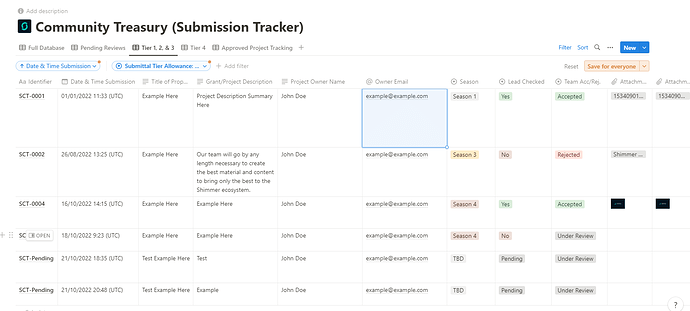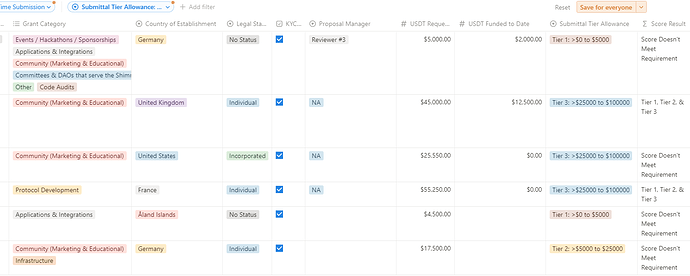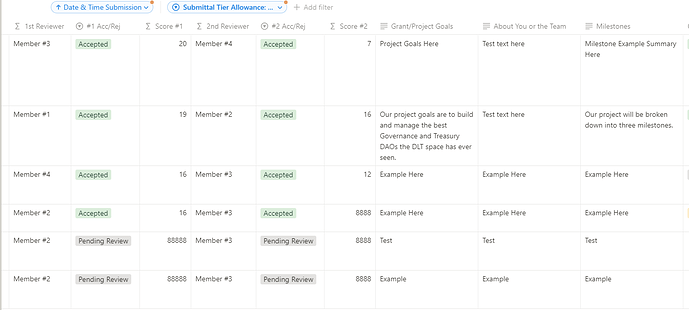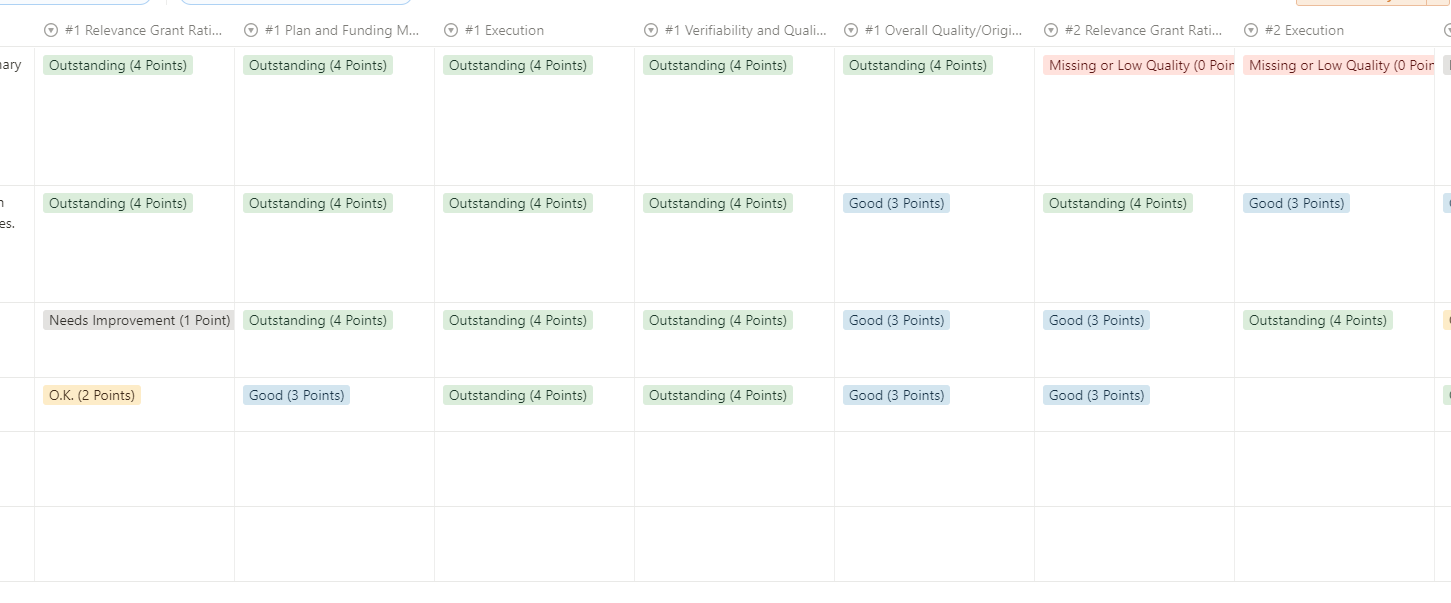Let’s look at the “max” employee cost for a single year.
Program Lead: $70/hr for 40 hrs a week = $2,800 per week. For 52 weeks = $145,600 USDT
Reviewer 1 (co-lead): $50/hr for 10 hrs a week = $500 per week. For 52 weeks = $26,000 USDT
Reviewer 2: $50/hr for 10 hrs a week = $500 per week. For 52 weeks = $26,000 USDT
Reviewer 3: $50/hr for 10 hrs a week = $500 per week. For 52 weeks = $26,000 USDT
Reviewer 4: $50/hr for 10 hrs a week = $500 per week. For 52 weeks = $26,000 USDT
So the total maximum running costs for the year, specifically for the base employees, would be: $249,600. If we were to set a relative cap on all other running costs (ie: legal retainers, bookkeeping, accounting, entity creation and maintenance, document submittal, KYC, web hosting, web applications, and miscellaneous) to let’s say, $100,000 or less annually; then the max yearly running costs would be around $350,000 USDT. Add an 8% overage given it is the first year running and that gives you a total of $378,000 USDT.
However, as it was stated earlier, the Program and co-lead will be the only ones that are filling their hours fully on a weekly basis. After a few months the co-lead may not even being filling those weekly hours. The other three reviewers, they would only be filling those hours if there are proposals for them to review. So right there you have $78,000, or 31% of the employee costs, that will be variable and most likely be a lower than the analyzed maximum yearly cost.
I believe it is also stated, that if the years funding is below $500,000 USDT in total, then the Treasury would stop and be put on hold. There would be no point to run a Treasury at a loss and be able to offer no grant funds to the community.
I agree with what you regarding a cost per proposal analysis to an extent. Yes, a $75,000 Tier 3 proposal that has 8 hours of cost put into by two reviewers, at a cost of $400 sounds legitimate. Yet compare that to an $800 grant Tier 1 grant in which two reviewers who spend 4 hrs together for a total cost of $200. Yes, in a very focused financial input/output observation the higher Tiers are better, but it doesn’t change the fact that Tier 1 quick funding is known, and found, to support ecosystems. Above that, the extra cost will always minimize a bit the scams that get through and thus loss of funds. So having Tier 1’s KYC and require 2 reviewers still allows for positive funding per proposal, but also mitigates risk of scams and nefarious activity by a single reviewer.
I don’t think right now we need to write into the framework exactly how many hours each Tier should be given. Though I do think the Program Lead will have to analyze and figure this out. Again, all of this is tracked and easily visible by the committee and particularly the program lead through automated forms. I was able to create a randomizer that randomly assigns reviewers to Tiers 1-to-3 grants. The program lead will easily be able to see how long each person is taking. Of course, if it is observable that a particular reviewer is taking extra time above and beyond the average of other reviewers, the program lead will have to have discuss this with that reviewer. The lead isn’t there strictly to manage the program, but also lead and manage the committee team as well.
Just to reiterate, I’m not sure where you get the $250 per hour per reviewer. In your example, if the Tier 1 grant is for $1,000 and two reviewers spend two hours each, then the cost of review would be $200 total. Also note, the Program Lead does not review projects. They aren’t even included in the randomizer. Maybe in an edge case, if all reviewers were busy, or maxed on hours, potentially, they would fill in for a single proposal or two. The point is though, the Program Leads role and responsibility is to manages and lead the Treasury, not spend time reviewing.
Personally I don’t like using a percentage of yearly funds for Running costs as a parameter. I believe this would lead to a situation where a program lead may be “looking” to spend funds simply because the funds are there to be spent. Rather, yearly running costs should be set for the year and adjusted if needed. Yes, in the first year there are a lot of unknowns, but once that first year is completed the Program Lead and committee should have a good idea as to how much the running costs are and will be the following year. Then, each year I personally believe the community should vote on for how much the committee gets to issue for grants for the year, and, how much is used for running costs. Now if the $SMR price, the price of shimmer sky rockets mid-year and tons of proposals come in all of a sudden; I think the committee should submit a proposal through the Governance Framework and get community approval to hire more reviewers or simply use a larger portion of funds for the increased running costs. The point is though I personally think, that they should go to the community for this approval.
As to salaries going 4x, again, the committee can’t simply make these decisions. That is why we are voting on this framework. If the framework is to change, the change needs to be completed through the governance framework and approved by the community. The committee is delegated and approved by the community to run the Treasury within a given set of structures. The committee in no way given free reign to go wild and use the allocated funds at will. As well, in the off chance a committee member, or the committee as a whole, acts nefariously or recklessly; the community would simply vote within the Governance Framework to halt the committee and end any Treasury funding until further community agreement.
As to whether we pay or not pay a salary to committee members, the community agrees that these positions need to be compensated for their time. Everyone during our governance meetings have come to this conclusion. It seems to be at present a minority belief that these positions should be offered with no compensation if there are community members out there. Saying that, a community member can easily donate back their compensation to the Treasury if they so want to. Saying all that, that doesn’t mean that strictly because this is a compensated position that 100% of the applicants will be fully qualified; no one has ever said that. We simply believe that these positions require committed time and thus should be compensated. As well, compensation to some extent opens the pool of applicants to individuals that only have the time available if they are indeed compensated and able to cover their personal expenses. Undoubtedly, regardless if the position is compensated or not, maybe more so with compensation; there will be applicants that are unqualified applying. I do agree that to some extent there will be some ecosystem popularity variable that supports one applicant over another. However, the only way to avoid such actions would be to have a centralized approval team, and even then, popularity would still play into the decision. The only method that allows the community to choose and delegate their committee members is to design a submittal system in which candidates submit, promote themselves, and then are voted on by the entire community as a whole. Personally I hold our community to a high standard. Yes, I believe a few people may vote simply based on a person’s popularity within the community; however, I believe the majority of the community will vote based on the applicants individuals qualifications they bring to the committee.



